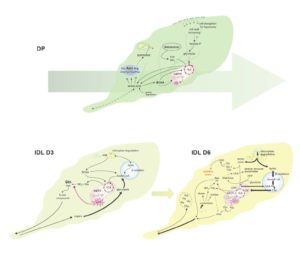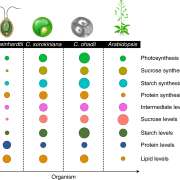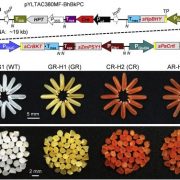Leaf Metabolism in Response to Dark
 One of the more prevalent methods used to initiate plant senescence under laboratory conditions is to grow plants in prolonged dark conditions. The course of “dark-induced senescence” depends upon whether individual leaves on the plant or the entire plant is darkened: an individually darkened leaf initiates senescence much more rapidly than the leaves of an intact darkened plant. Combining transcriptomic and metabolomic approaches in Arabidopsis, Law et al. (10.1104/pp.18.00062) present an overview of the metabolic strategies that are employed in response to these two different darkening treatments. They report that when entire plants are darkened, carbon starvation initiates a profound metabolic readjustment in which branched-chain amino acids and potentially monosaccharides released from cell wall loosening became important substrates for maintaining minimal ATP production. Concomitantly, the increased accumulation of amino acids with a high nitrogen-carbon ratio may provide a safety mechanism for the storage of metabolically derived cytotoxic ammonium and a pool of nitrogen that can be utilized upon the return to typical growth conditions. In contrast, in individually darkened leaves, a temporal and differential exchange of metabolites, including sugars and amino acids, between the darkened leaf and the rest of the plant is initiated This active transport could be the basis for a progressive metabolic shift in the substrates fueling mitochondrial activities, which are central to the catabolic reactions facilitating the retrieval of nutrients from the senescing leaf. The authors propose a working model that provides an overview of the different metabolic strategies employed by plants in response to these two different darkening treatments.
One of the more prevalent methods used to initiate plant senescence under laboratory conditions is to grow plants in prolonged dark conditions. The course of “dark-induced senescence” depends upon whether individual leaves on the plant or the entire plant is darkened: an individually darkened leaf initiates senescence much more rapidly than the leaves of an intact darkened plant. Combining transcriptomic and metabolomic approaches in Arabidopsis, Law et al. (10.1104/pp.18.00062) present an overview of the metabolic strategies that are employed in response to these two different darkening treatments. They report that when entire plants are darkened, carbon starvation initiates a profound metabolic readjustment in which branched-chain amino acids and potentially monosaccharides released from cell wall loosening became important substrates for maintaining minimal ATP production. Concomitantly, the increased accumulation of amino acids with a high nitrogen-carbon ratio may provide a safety mechanism for the storage of metabolically derived cytotoxic ammonium and a pool of nitrogen that can be utilized upon the return to typical growth conditions. In contrast, in individually darkened leaves, a temporal and differential exchange of metabolites, including sugars and amino acids, between the darkened leaf and the rest of the plant is initiated This active transport could be the basis for a progressive metabolic shift in the substrates fueling mitochondrial activities, which are central to the catabolic reactions facilitating the retrieval of nutrients from the senescing leaf. The authors propose a working model that provides an overview of the different metabolic strategies employed by plants in response to these two different darkening treatments.









